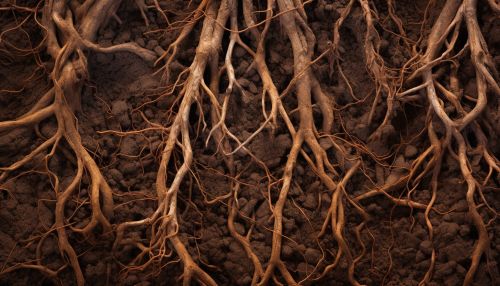The Science of Plant Root Architecture and Soil Interactions
Introduction
Plant root architecture refers to the spatial configuration of a plant's root system in the soil. This architecture is influenced by both genetic factors and external stimuli, including soil properties and environmental conditions. Understanding the science of plant root architecture and its interactions with soil is crucial in fields such as agronomy, plant breeding, and environmental science.


Root Architecture Types
There are several types of root architecture, each with unique characteristics and adaptations to different soil conditions. These include:
- Taproot systems, where a single large root (the taproot) grows vertically downward with smaller lateral roots branching off from it. This system is common in dicotyledonous plants and is advantageous in deep soils where water and nutrients are located far below the surface.
- Fibrous root systems, where numerous small roots of similar diameter spread out in all directions from the plant stem. This system is typical of monocotyledonous plants and is well-suited to shallow soils where resources are concentrated near the surface.
- Adventitious root systems, where roots form from non-root tissues such as stems or leaves. These systems can be beneficial in environments with fluctuating soil conditions, as they allow plants to rapidly adjust their root architecture in response to changes in resource availability.
Genetic Control of Root Architecture
The development and growth of a plant's root system is controlled by a complex network of genes and signaling pathways. Key genes involved in root architecture include those that regulate cell division and differentiation, hormone production and response, and responses to environmental stimuli. For example, the gene ARF7 is known to control lateral root formation in response to auxin, a plant hormone that promotes root growth.
Soil Properties and Root Architecture
Soil properties play a significant role in shaping plant root architecture. Factors such as soil texture, structure, moisture content, nutrient availability, and the presence of other organisms can all influence the development and growth of a plant's root system.
- Soil texture: The size and arrangement of soil particles can affect root penetration and growth. For example, in compacted or clayey soils, roots may grow more horizontally or exhibit a shallower architecture due to physical resistance.
- Soil structure: The arrangement of soil particles into aggregates or clods can create pores and channels that facilitate root penetration and exploration. Well-structured soils typically promote more extensive and deeper root systems.
- Soil moisture: Water availability in the soil can influence root growth and distribution. In dry conditions, roots may grow deeper to access water reserves, while in waterlogged soils, roots may grow more shallowly to avoid oxygen deficiency.
- Soil nutrients: The distribution of nutrients in the soil can affect root architecture. Roots often proliferate in nutrient-rich zones, a phenomenon known as nutrient foraging.
- Soil microorganisms: Interactions with soil microorganisms, including symbiotic relationships with mycorrhizal fungi and nitrogen-fixing bacteria, can influence root architecture and function.
Root-Soil Interactions and Plant Performance
The interaction between a plant's root system and the soil environment can significantly impact plant performance, including growth, nutrient uptake, and stress tolerance.
- Growth: A well-developed root system can enhance plant growth by improving access to water and nutrients in the soil. Conversely, poor root development can limit plant growth, especially under adverse soil conditions.
- Nutrient uptake: The architecture of a plant's root system can influence its ability to acquire nutrients from the soil. For example, a more extensive root system can increase the plant's nutrient uptake capacity by exploring a larger soil volume.
- Stress tolerance: Root architecture can also affect a plant's ability to tolerate stress conditions such as drought, salinity, and nutrient deficiency. For instance, deep-rooting plants are often more drought-tolerant as they can access water reserves deep in the soil.
Future Directions in Root Architecture Research
Research on plant root architecture and soil interactions continues to be a vibrant field of study, with many exciting directions for future exploration. These include the use of advanced technologies such as genomics, phenomics, and computer simulation to better understand the genetic control of root architecture and its response to soil conditions. Additionally, there is growing interest in harnessing this knowledge to improve crop performance and sustainability in the face of climate change and increasing global food demand.
